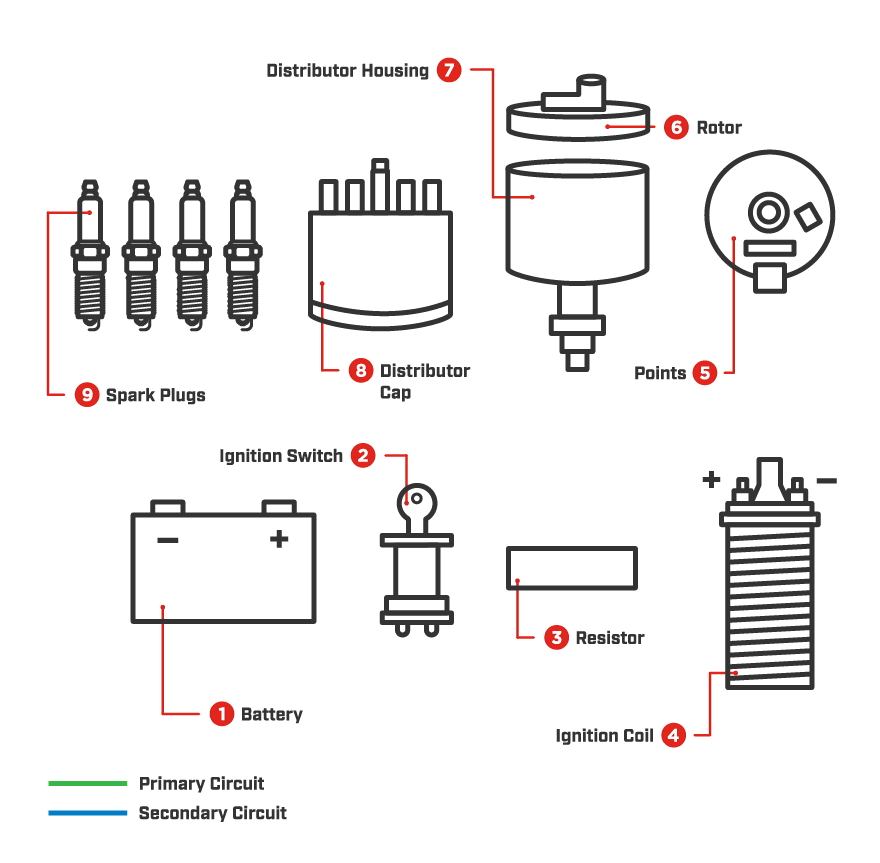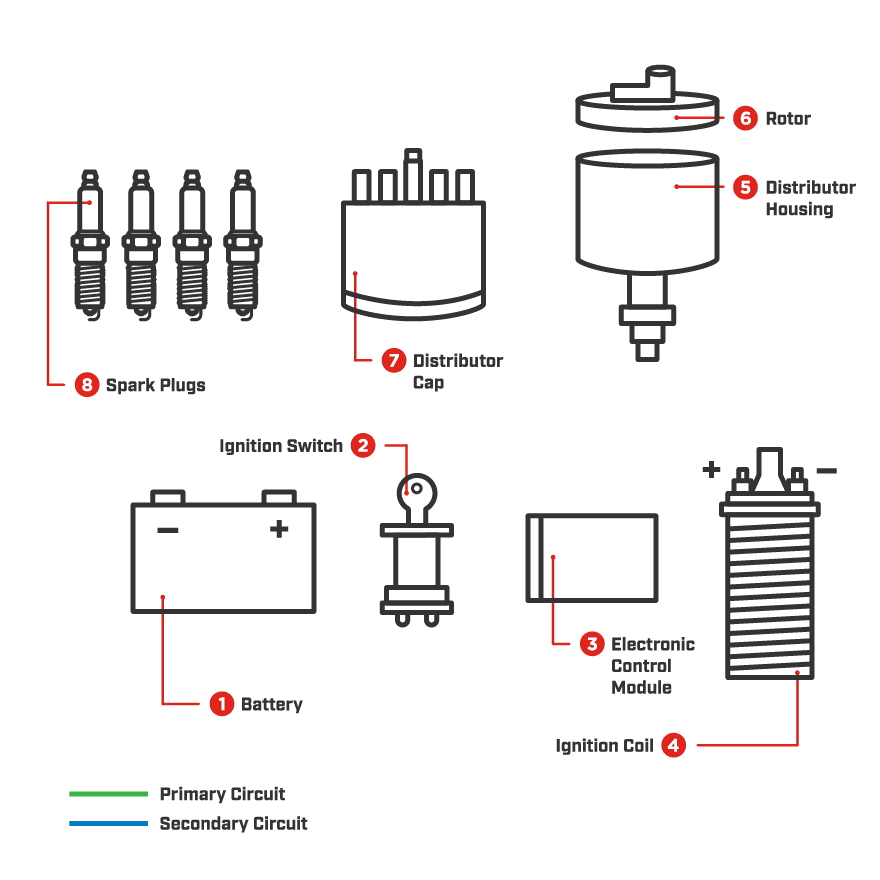Although there are many different types of ignition systems on the market today, most can be placed in one of the three groups:
- Conventional breaker-point ignition (in use since the early 1900s)
- Electronic ignition (popular since the early 1970s)
- Distributorless ignition (introduced in the mid-1980s)
Here’s an overview on how each of these systems operate.
Conventional Ignition System

An automotive ignition system is divided into two electrical circuits -- the primary and secondary circuits.
The primary circuit carries low voltage. This circuit operates only on battery current and is controlled by the breaker points and the ignition switch. When the ignition key is turned on, a low voltage current from the battery flows through the primary windings of the ignition coil, through the breaker points and back to the battery. This current flow causes a magnetic field to form around the coil.
The secondary circuit consists of the secondary windings in the coil, the high tension lead between the distributor and the coil (commonly called the coil wire) on external coil distributors, the distributor cap, the distributor rotor, the spark plug leads and the spark plugs. As the engine rotates, the distributor shaft cam turns until the high point on the cam causes the breaker points to separate suddenly. Instantaneously, when the points open (separate) current flow stops through the primary windings of the ignition coil. This causes the magnetic field to collapse around the coil. The condenser absorbs the energy and prevents arcing between the points each time they open. This condenser also aids in the rapid collapse of the magnetic field.
The line of flux in the magnetic field cut through the secondary windings of the ignition coil, creating a high voltage - high enough to jump the gaps between the rotor and the distributor cap terminals, and the electrodes at the base of the spark plug. Assuming that the engine is properly timed, the spark reaches the air-fuel mixture in the cylinder and combustion begins.
As the distributor continues to rotate, electrical contact between the rotor and distributor cap terminal is broken, stopping the secondary flow. At the same time, breaker points close to the complete the primary circuit, allowing primary current to flow. This primary current will again create a magnetic field and the cycle is repeated for the next cylinder in the firing order.
This process takes place within a few milliseconds. In fact, it happens approximately 18,000 times per minute at 90 miles per hour.
Electronic Ignition System
The need for higher mileage, reduced emissions and greater reliability has led to the development of the electronic ignition system.
This system still has a distributor, but the breaker points have been replaced with a pickup coil, and there’s an electronic ignition control module.

Like conventional ignition systems, electronic systems have two circuits: a primary circuit and a secondary circuit. The entire secondary circuit is the same as in a conventional ignition system. In addition, the section of the primary circuit from the battery to the battery terminal at the coil is the same as in a conventional ignition system.
With the ignition switch turned on, primary (battery) current flows from the battery through the ignition switch to the coil primary windings. Primary current is turned on and off by the action of the armature as it revolves past the pickup coil or sensor. As each tooth of the armature nears the pickup coil, it creates a voltage that signals the electronic module to turn off the coil primary current. A timing circuit in the module will turn the current on again after the coil field has collapsed. When the current is off, however, the magnetic field built up in the coil is allowed to collapse, which causes a high voltage in the secondary windings of the coil. It is now operating on the secondary ignition circuit, which is the same as in a conventional ignition system.
Distributorless Ignition System
Newest type of ignition system.
Very different from conventional and electronic – coils sit directly on top of the spark plugs, no spark plug wires, and the system is electronic.
-1557923939941.gif)
The third type of ignition system is the distributorless ignition. The spark plugs are fired directly from the coils. Spark plug timing is controlled by an ignition module and the engine computer. The distributorless ignition system may have one coil per cylinder or one coil for each pair of cylinders.
There are several advantages of not having a distributor:
No timing adjustments.
No distributor cap and rotor.
No moving parts to wear out.
No distributor to accumulate moisture and cause starting problems.
No distributor to drive thus providing less engine drag.
Learn more about quality spark plugs, find your car part, or find where to buy your auto part today.
The content contained in this article is for informational purposes only and should not be used in lieu of seeking professional advice from a certified technician or mechanic. We encourage you to consult with a certified technician or mechanic if you have specific questions or concerns relating to any of the topics covered herein. Under no circumstances will we be liable for any loss or damage caused by your reliance on any content.
Related Parts
Champion® offers a wide variety of products for all your automotive needs.
Check them out!